| PEOPLE |
YEAR: 2011
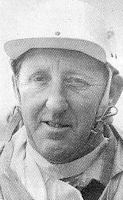 |
There was standing room only om Monday at the funeral service for harness racing identity Henry Skinner who died in Invercargill on June 20, aged 78. He was described in the many tributes as a no fuss horseman with great judgement and practical skills. This was backed by his results.
In a driving career spanning 45 years, from his first drive in the 1956-57 season to his last in the 2000-01 term, Skinner reined the winners of 717 races. Among his major successes were the 1979 Auckland Cup with Sapling, the New Zealand Messenger Stakes in 1976 and 1978 with Forto Prontezza and Sapling, the 1989 New Zealand 2-Year-Old Championship with Honkin Vision and the 1989 Dominion Handicap with Tobago.
He also suffered some near misses suc as when Hi Foyle came up against Young Quinn in the 1975 Inter-Dominion Final, or when Sapling was nutted in both the 1978 New Zealand Cup and the Inter-Dominion Final, or when No Return got clear too late in the 1993 New Zealand Derby. In addition to those second placings in major races, he came close in another New Zealand Cup when Forto Prontezza, a pacer he also trained, came third.
Prior to his entry into harness racing, Skinner had been an apprentice jockey and won his first race at Tapanui in 1948 as a 15-year-old. Among his key wins were the 1949 Invercargill Gold Cup on Gunther, carrying seven stone seven pounds (47.75 kgs) and consecutive Great Western Steeplchases aboard The Denbigh in 1951 and 1952, the latest carrying 11 stone one pound (70.5 kgs). Not long after that, increasing weight led to him swapping saddles for sulkies.
Although it took him 12 seasons to reach his first 100 winners, those were in days when harness racing dates in the south were limited, as were the number of races each day. He topped 30 in a season for the first time with 38 wins in the 1973-74 term and another eight times later. His best tally, of 39, came in 1986-87.
Skinner's solo training career began in 1960 but he netted just the on win in his first term. By the time it ended in 2007, his tally was 327 wins. In addition, a successful five-term partnership with Allan Devery - from 1987 - yielded another 76 wins. Honkin Vision, who won both the 1989 2-year-old Sires' Stakes Final and the 3-year-old version six months later, was their biggest winner.
Skinner was carried into the service to the 1965 Herman's Hermits hit 'I'm Henery the Eigth, I Am' and his daughter Tracey Laker recalled the times he would ring and sing the song down the phone line to her to report on a successful day at the races. She also remembered going to races with him in the days when parking attendants were required, and spoke of the lack of success the white coated brigade had when trying to change her father's parking habits.
Peter Davis, who worked for him for about six years, spoke of the ongoing Skinner influence. Some of the routines he followed, such as when mouthing, Davis said, have stuck with him to this day.
Skinner's casket was draped with the red and white colours he wore so prominently for many years. He is survived by two daughters, Tracey, and Vicky Popham, and five grand-children Morgan, Nic, Georgia, Meg and Flynn.
Credit: Mac Henry writing in HRWeekly 29Jun11
YEAR: 2002
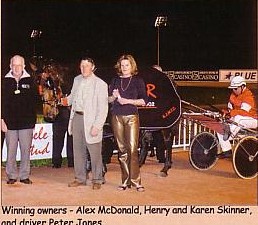 |
The Nevele R Fillies Final last Friday night was open to all-comers when the favourite Elect To Live ran out of steam at the top of the straight.
This unexpected development was a surprise invitation to the others, and it was not one of the favourites but Whanau who emerged with the commitment to get home first. It was not by much, half a head to be official, and 10 metres out it appeared as though Angela Jane had edged past. And she had; driver Mark Purdon was sure of it. But over the next 10 metres, Whanau won it back, and caused a huge upset.
The same filly had run well below her best in the New Zealand Oaks the previous week. Trainer Henry Skinner put it down to the fact she pulled hard, but in case he had missed something he got Robert Cameron to handle her when she fast-worked on the Wednesday before the race. Skinner really wasn't in the best shape because he had the flu, but Cameron reported that she worked as well as he would have liked. "I thought she was okay for the Oaks," said Skinner, "but she didn't get the best of runs. But I was dissappointed about where she finished. I had her blood done after that, and everything was right there," he said. On reflection, he thought she had had some bad luck in some of her previous races. In one, she made a break at the start, and when she was due for another she had to miss it because of a cold. It meant she had to do some catching up on what she had missed at the trials.
As good as she went on the night, Whanau also had the benefit of a splendid drive by Peter Jones who was also as good as anyone on the night. He put Lento's daughter into a nice place, midfield on the outer, then caught the back of Hot Blooded Woman who was making some headway forward at the 700 metre mark. It took her far enough for her to strike out on her own near the 500 metres, and Whanau moved into it at a quicker rate than Elect To Live who was moving back. She was not alone because Goodnight Aveross was again showing a lot of cheek and Angela Jane had made her own ground from the back and was chasing hard. Whanau stuck to her guns to give sire Sands A Flyin his second successive winner of the race, following that of Sparks A Flyin last year.
Skinner, who trains a small team at Branxholme and made his name with some wonderful horses such as Sapling, Sure Mart, Forto Prontezza and No Return, races the filly with his wife Karen and the horse's co-breeder, Alex McDonald. McDonald trained and part-owned Lento, (MR 1:56.4, 2000m), with Lorraine Coutts. She was sold last September, in foal to Dream Away, to Robert Famularo's Cavalla Breeding. Lento is also the dam of a 2-year-old by Sir Vancelot, owned by Keith and Lorraine Coutts, who bred Whanau in partnership with McDonald.
Credit: Mike Grainger writing in HRWeekly 15May02
YEAR: 1993
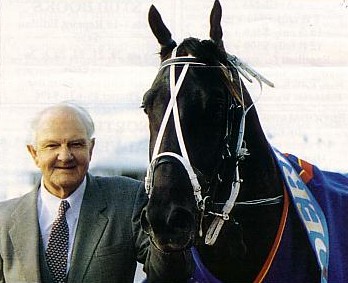 |
| Roy Purdon and Mark Roy |
A 'rough one' put in by Southland star No return cost him dearly in the John Brandon 30 NZ Derby, but in the end the success of Mark Roy was thoroughly deserved.
"He has thrown a shoe at some stage...probably at the start when he went a bit rough," trainer-driver Henry Skinner lamented later. Beaten out of the gate from the pole, No Return, the dominating favourite going for the Triple Crown, settled three back on the fence and never had an opportunity to get out until after they swung for home. While he flew once into the clear, Mark Roy had a winning break and held him out by a short neck. "I would have been quite happy to keep the front, but it didn't work out that way," said Skinner.
It was shade of deja vu for Skinner, who in 1990 won the first two legs with Honkin Vision. Honkin Vision also went into the Derby a hot favourite, but after attempting to lead all the way, the constant attentions of the Purdon-trained runners in The Unicorn, Mark Hanover and Christopher Vance, saw him fade to fifth. Ironically, that event was the only previous occasion Mark Purdon, the successful driver on Saturday, had driven in the race. He drove Mark Roy's half-brother Mark Hanover, the horse he would win the Auckland Inter-Dominion with the following year, into fourth on that occasion.
The Purdons had three runners engaged also this year, with 28-year-old Mark renewing his association with Mark Roy the previous Saturday after seven weeks on the sideline with a broken arm, a legacy of the sales series smash in mid-February. Elder brother Barry again took the reins on Hitchcock, while Tony Herlihy guided Mister Wolf Blass.
Back early from the outside of the second line, Mark Roy was on the move in the middle stages, following Mark Craig around when the tempo increased noticeably passing the mile. Trapped without cover three wide from the 1400m, Mark Roy was still able to dash clear in the run home and had enough in reserve to fend off the late claim of No Return. He paced the mobile 2600m in 3:16.2, last 800m in 58.4 and 400m in 28. "It might have looked like a tough run, but he relaxed nicely out there. It is better to have them that way than fighting you," said Mark.
Mark had been in charge of Diamond Field and Mister Wolf Blass at Jim Dalgety's West Melton property during their stay, with Barry looking after the bulk of the team at Jeff Whittakers. Mark Roy has in recent weeks been troubled by quarter cracks, but the use of bar shoes and constant treatment has enabled him to keep racing. The Derby was his seventh win from 23 starts, and along with 11 placings, took Mark Roy's stakes talley on to $163,000. Like Mark Hanover, Mark Roy is raced by co-trainer Roy Purdon, Robert and Mrs Janet Reid and the Lorna Reid Syndicate. "Robert was down for the first two nights but did not come back for the Derby. He had no luck at all on the earlier nights," Mark said.
For Roy and Barry it was their second Derby in a row, having won the race last year with Kiwi Scooter. Roy watched the race from the public grandstand and would have done so alone had an old friend in Derek Jones not spotted him. "Roy came over and stood beside me when we won the NZ Cup with Hands Down," recalled Jones. "He wasn't going to bother coming down to the birdcage, but I set the pace for him," he added.
Miss Clevedon, whose first three foals are Mark Hanover (US1:53.4, winner of over $700,000 in NZ), Roy's Advice (2:00.3, 2 NZ wins) and Mark Roy, unfortunately died in 1991 after foaling a colt by New York Motoring. In between those foals, the Noodlum mare left a Vance Hanover filly, now three, which has not shown the same ability as her relatives to this stage. She is however the only filly left by the former open class mare. "Mark Hanover was brilliant right from the start, while this fellow has steadily improved all along," said Mark.
Bee Bee Cee, the second of three Southland-trained runners, enjoyed the trail behind Hitchcock and stuck on well for third in a gap of four lengths. He shaded Mark Craig and Franco's Chef, who both battled well after improving in the middle stages.
Credit: Frank Marrion writing in HRWeekly 15Apr93
YEAR: 1990
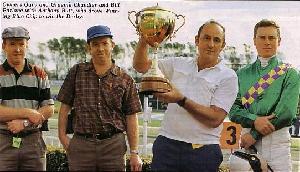 |
| The connections of Winning Blue Chip |
After sitting alone at the back, unfancied Winning Blue Chip came through to win the $175,000 John Brandon 30 New Zealand Derby.
The chunky bay gelding picked off seven tiring rivals to cause the biggest Derby upset since Naval Officer won the classic in 1984 when only five finished. That was the second surprise. The first was the sinking of Honkin Vision, the raging favourite who was beaten, and badly beaten, with less than 200 metres to run. And the third surprise was the remarkable achievement of Winning Blue Chip to demolish Inky Lord's New Zealand age group record of 3:15.1 by pounding out 3:12.2 for a mobile 2600m.
It was a muted audience who saw the scene unfold, because Winning Blue Chip rated in none of the pre-race forecasts and in the Brandon preludes had done nothing to suggest he was in the same league as the favourites. Driver Anthony Butt said: "I always thought he was a bit below the best of them. The only show I had was if they went hard all the way. I knew I had to take all the short cuts. He was not good enough to go around them."
Henry Skinner took Honkin Vision to the front, as the draw said he would. Sweating freely in the warmer conditions, Honkin Vision made play at better than a 2:00 clip, making the pace hard on the others and harder on himself. Said Skinner: "I was starting to get pretty busy at the quarter." No wonder. The horse had cut out his 2400 metres in 2:57.9 and was starting to hang his head. The Unicorn took him easily. He soon came to the end of it, allowing Winning Blue Chip to pick him off 50 metres out and race clear to win by three-quarters of a length.
The winner is trained by Barrie Lilley, who is not a household name in New Zealand harness racing circles. Formerly a freezing worker, Lilley, aged 46, took out a professional trainer's licence two years ago on the death of his father. One of those he started training was a colt by second season sire Bo Scots Blue Chip from Winning Maid, a winning Willie Win mare formerly trained by Murray Rennie.
Bred by Doody Townley and FA and Mrs JM Stakes of Ashburton, Winning Maid was from Locksley Maid, by Young Charles from Jonell, by Garrison Hanover from Mighty Imp, by Dillon Hall. Winning Maid was raced by Bill Parlane and twin brothers Graeme and Gary Chandler, who bred her to Noodlum after winning one race. She produced Mighty Adios to this mating, returned to win another race, then went to Nevele R Stud to produce her classic winner. She is also the dam of a Nero's B B filly and this season was served by Paulsboro.
On times, Winning Blue Chip was no faint hope. He had recorded a best time of 3:17.5 for the distance, and only Seafield Inca had gone quicker. "But although we didn't expect anything like this, his blood has been out for the last couple of weeks and credit must go to the Halswell Clinic vets for the work they have done getting him right," said Parlane. "He just did not fire on the first two nights like I knew he could."
Credit: Mike Grainger writing in HR Weekly
YEAR: 1989
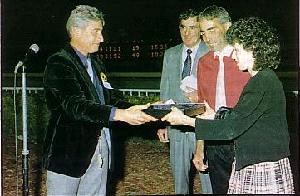 |
| Jon Gadsby, TV3, presents the trophy to the owners of Tobago |
Not since Dictation took nearly 10 seconds off the record for winning the Dominion Handicap has there been such a pronounced improvement in time as the one Tobago posted. In warm, near perfect weather conditions, and on a track tailored to meet such accomplishments, Tobago came through 3200m in 4:08.4. To do this, he was not alone at the end of the $150,000 TV3 Network Dominion Handicap.
Those who pressed him without mercy were Directorship, who was just a nose from taking $97,500 and old Troppo, the veteran of 117 starts, who looked in for the kill 50 metres from the finish. Tobago and Directorship had the best trips of all. Both were in midfield on the outer, and neither were used to the extent of Drott Moss and Idle Scott, who were baked before the turn after spending a great deal of energy making their runs in the middle stages. While the two northerners battled so hard to gain a toehold in the race, Troppo remained back and was still almost last at the 500 metres. By then the cracks had started to appear and first Tobago, then Directorship moved to open them up. Once the pair drew clear, the table seemed set, until Troppo began to thread his way after them, going at what seemed a winning rate. But he set his compass on the rail and the angle of this passage over the last 50 metres might have cost him a closer placing. As it was, he probably came up short just a few strides from the finish, but added to the chorus of an exciting end to a record race. The favourite Tyron Scottie ran 7th after leading at the 2000m and trailing at the 1400m. "He felt uncomfortable after a furlong," said driver Patrick O'Reilly jun.
When Dictation won the Dominion in 1950, he recorded 4:16.6. The previous best then was the 4:26.2 set by Wrackler in 1932. Before Tobago's 4:08.4, the record was Scotch Tar's 1978 4:11.6, which, when record changes are usually measured nowdays in 10ths, is quite a remarkable reduction. Of course, Tobago always had a time like this in him. Earlier this season, he became the first trotter in New Zealand to run a mile in less than 2:00, which he did at Ashburton in 1:59.3.
Tobago is a seven-year-old son of Game Pride and Ann's Globe, a mare by Johnny Globe. He is small but compact; a bay of good colour. His mother was raced by Harold and Joan Jenkins, the parents of Tobago's present owners, Ray Jenkins and his sister Diane Kean. The senior Jenkins raced Our Jimmy from Bob Young's stable when he finished fourth in the Dominion Handicap won by Min Scott in 1963. Ann's Globe was tried as a pacer by Les Norman, but it wasn't until she entered the stable of Arthur and Maurice Skinner and switched to trotting that she revealed ability. "I think they had only had her about six weeks when she won at Roxburgh for Henry Skinner," said Ray. Ann's Globe went on to win six races, including two in Canterbury when trained by Jack Carmichael. On retiring, the Jenkins gave the mare to Ray and Diane for breeding. "It's a real family thing with us. They are getting on, and they probably thought we are a bit more up with the breeding now," he said.
"The thing with Tobago is that he just didn't stop...he could just keep on going. I put that down to the Johnny Globe blood coming through...they've got the guts. With Tobago now, we'll go for it. He'll race at Auckland next and there's the $100,000 bonus if he wins either two of the Inter-Dominion Grand Final, the National Trot or the Rowe Cup this season," he said.
Ann's Globe is not in foal, and it is very unlikely the two partners will use her this season. "We are considering lending her out, but we can't say to just who at the moment," said Ray. Among the mares being sent to stud by the family this season are Montego (Sir Dalrae-Ann's Globe), Globe Pride, Blue Nun (dam of French Wine) and Beat The Freeze, the latter three all booked to Chiola Hanover.
Credit: Mike Grainger writing in HR Weekly
YEAR: 1978
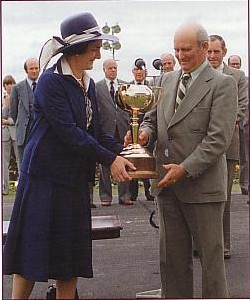 |
| Adam Hunter receives the Cup from Colleen McDermott, wife of the Met President |
Last season's top sire, the now defunct Scottish Command, left his second successive New Zealand Cup winner when Trusty Scot bested the favourite Sapling at the end of a relatively tame contest.
Trusty Scot, only regarded as an outside Cup chance when he resumed racing in the Ashburton Fying Stakes in October, firmed as one of the best prospects for last Tuesday's big event when he won at Ashburton, then followed it up with a win in the final lead-up Cup race, the Kaikoura Cup nine days before the Addington feature.
Some notable 'judges' had expressed doubts as to the patience and temperament of Trusty Scot's young driver, Henderson Hunter, who at 26, was the youngest driver in last Tuesday's field. But Henderson drove with all the skill and aplomb of a reinsman of many more years experience in landing home the Southland-bred entire a half length winner over Sapling. Trusty Scot made a brilliant beginning and led by three lengths after 100 metres, but Henderson then eased him to trail as Sapling sped round the field to lead at the end of 600 metres.
Henry Skinner looked set to land his first Cup winner as he dictated the terms entirely to his own satisfaction, but Trusty Scot pulled out from the trail at the turn, ranged up alongside 150 metres out and outstayed the pacemaker by half a length. Henderson, who races Trusty Scot in partnership with his father Adam, moved to Ohoka last winter to train at the property of his father-in-law, Bill Bagrie, and dedicated his time towards preparing the talented pacer for the Cup.
The finish of the Cup proved a triumph for New Zealand-bred stallions, as the runner-up, Sapling, is by the veteran sire Young Charles and the only other runner by a New Zealand sire, Lord Module, finished fifth. He is by Lordship.
As a spectacle, the race was relatively tame, only developing into a true staying test over the last 1600 metres, the first 1600 taking 2:10.2. The last 1600 took 2:02.6 with the last 800 metres in a startling 57.7 and the final 400 metres in 29.2. With such a fast pace being set only over the last 1600 metres, those trying to improve from the back were left with little chance, and virtually the first four on the home turn filled those placings at the finish.
Rocky Tryax, who settled three back on the rails and was tracked throughout by Wee Win, filled third a length and a half behind Sapling, with Wee Win battling into fourth half a neck back, one place further back than he finished in last year's Cup. Lord Module, attempting to become only the fourth four-year-old in the 75 year history of the event to win the Cup, was far from disgraced in finishing fifth. He stood on the mark after becoming restless in the No.1 barrier position and was six back on the rails when the field settled into position. He worked his way through the traffic on the turn without really getting a clear run and did well under the circumstances.
Belmer's Image made ground for sixth ahead of the North Islanders Bronze Trail and Rondel. Bronze Trail made ground after a slow start but Rondel enjoyed the run of the race and faded from the home turn. Little could be said of the remainder who were well and truly beaten.
Credit: Editor NZ Trotting Calendar
YEAR: 1975
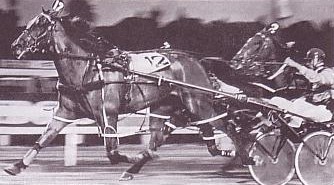 |
| Young Quinn and John Langdon |
As the 1975 Inter-Dominions in Auckland loomed, New Zealand's chances of repelling the formidable Australian assault and ending their almost complete domination of the Championship for a decade seemed to be on very shaky ground. Outside of Stella Frost's promoted win at Addington four years earlier, following the disqualification of Junior's Image, and Phil Coulson for seven years - later remitted to four years by the NZ Trotting Conference - after a caffeine positive, New Zealand had not looked even close to winning an Inter-Dominion since the 1965 series in Dunedin was shared by Jay Ar and Robin Dundee.
This included the previous Inter-Dominion at Alexandra Park in 1968, a series dominated by Tasmanian champion Halwes and following his shock withdrawal from the Final with a quarter crack less than a hour before attempting a clean sweep, ultimately won by NSW's First Lee. This was Australia's first Inter-Dominion win on New Zealand soil, which was not supposed to happen. And the Forbury Park success had hardly counted, what with Blazing Globe being the only Australian contender of any note. A son of Stormyway and the grand NZ mare Thelma Globe trained by Perc Hall at Penrith, Blazing Globe won a heat on the third night, but a couple of fourths in the heats was the best that could be managed by the combined efforts of Guiness (NSW), Palpitate (Vic) and Minton Hall and Pacing Lawn from WA, and their trip seemed mostly about taking in the scenery.
The 11-strong Australian challenge for the Pacing Championship in 1975 though was spearheaded by two-time winner Hondo Grattan and well established stars in Paleface Adios, Just Too Good, Tarcoola Frost and Royal Gaze, all but the latter from NSW. Hondo Grattan had won 44 races at that point, while Just Too Good had won 46 and Paleface Adios 43 and Royal Gaze had just won the Hunter Cup.
Then a week out from opening night came the devastating news that Robalan had been withdrawn after being troubled by an abscess on the chest. The 8-year-old free-legged champion had brilliantly won that season's NZ Cup and NZ Free-For-All, the latter for the third consecutive year and in world record time, where a 5-year-old Young Quinn had arrived in Christchurch off the back of eight straight wins and proved fallible.
A few months later, New Zealand's hopes of an Inter-Dominion win seemed to rest squarely on the shoulders of the Auckland and Wellington Cup winner Young Quinn. The likes of Hi Foyle, Speedy Guest, Vanadium, and the 4-year-olds Captain Harcourt, Master Dean and Kotare Legend were considered good class, but hardly capable of beating the Australian champions even with a head start in the handicaps. But this was Alexandra Park of course, and a whole new ball game, or direction, for the visitors. And they were about to run into a horse who by the end of the Championship, would be talked about as the best seen since Cardigan Bay.
Young Quinn, affectionately nicknamed 'Garbage' by his Edendale connections due to his habit of eating everything in sight as a youngster, including his bedding, would also by the end of his 5-year-old campaign earn the label of 'the Mighty Quinn' from none other than Peter Wolfenden, who since being spoiled by 'Cardy' had rarely been heard to utter a generous word for any other horse.
When the dust had settled on the season, Young Quinn had raced 22 times in New Zealand for 19 wins, two thirds and a seventh, and in Australia, three times for two wins and a fourth, the latter in a heat of the Lord Mayor's Cup at Harold Park from 25m not long after brilliantly downing Mitchell Victory, Royal Gaze, Hondo Grattan, Paleface Adios and Adios Victor in the Miracle Mile, and Hondo Grattan in the Hurricane Stakes. Robalan had set the record for wins in NZ in a season the previous year at 12, while Young Quinn's 10 consecutive wins to complete his campaign was also a record within a NZ season. He earned $149,961 when no other horse had topped $100,000 in a year and became the first horse in Australasia to top $200,000 in career winnings, at a point when the only other six-figure winners were Robalan ($164,020), Arapaho ($128,345) and Lordship ($113,790). In today's terms, it was easily a million dollar-plus winning season.
He set New Zealand race records for one mile (1:57 in the NZ Miracle Mile) and two miles (4:06.7) and his records for 2200m, 2600m and 2700m from a stand were faster than the records from mobiles.
Bud Baynes and his son Des had bred Young Quinn after the former had bought his out of form dam, the Hal Tryax mare Loyal Trick, for a few hundred dollars in what was just his second venture into standardbred ownership, having earlier won a race with a son of Hal Tryax in Hal Away. Convinced he could get the Southland 3yo Stakes winner back into form, Baynes soon discovered that Loyal Trick was too far gone with arthritis to be a racing prospect and bred her to Young Charles, who was standing at stud for his brother Colin at nearby Ferndale. The resulting filly in Judy Charles was sold as a yearling to Christchurch's Colin McLachlan and had three wins, losing one on a protest, while Loyal Trick's third foal and first colt, by Young Charles, died of tetanus. Des Baynes was 19 and working for Colin, who coincidentally then offered him a free service to Young Charles, and Bud loaned Loyal Trick on the understanding they would race the foal together.
A very precocious youngster, Young Quinn had won seven juvenile trials before making his debut in the Mercer Stakes at Addington in January, 1972, where Baynes had asked a polished former Southland horseman in Robert Cameron to drive. Cameron agreed, but during the float trip to Christchurch he said to Baynes "they're pretty good up at Addington; I think we'll be lucky if we finish about sixth." Young Quinn was 12th at the half but got up to impressively down smart sorts in Willie Win and Marc Bohan and by the end of the season had won eight races from 10 starts, equalling the juvenile record for races won by Sam Tryax, and taken out the prized double of the Sapling Stakes and Juvenile Championship.
An early knee injury cost him dearly as a 3-year-old, and attempting to win the NZ Derby in his season's debut when not ready set him back even further. But after being placed with Charlie Hunter at Cambridge for a failed Great Northern Derby tilt, Young Quinn began to fulfil his considerable earlier promise at four, a season he started in open class. He chased Arapaho home in the NZ and Auckland Cups and came up half a head short of Robalan in the Miracle Mile, won in 1:58, but his wins included the Allan Matson and Ollivier at the NZ Cup Meeting with Hunter at the helm.
His failures however included the Perth Inter-Dominions, where he made no impression after not travelling well and failing to settle at all in the heat. Returning home to romp away with free-for-all in Auckland in March, Young Quinn went for a well earned rest, and was soon back in the new season and sweeping all northern rivals aside with seven straight wins in the hands of Wolfenden heading into the NZ Cup carnival. Starting hot favourite in the Cup, he got hooked up in an early speed duel and pulled himself into the ground, and only class carried him into third as Robalan carried the day in his fourth attempt over Kotare Legend, while he recovered from last early to finish a distant third in the FFA.
Another Allan Matson from 25m in record time was a mere formality in Robalan's absence however and then came the Miracle Mile in Australasian record time of 1:57, where Robalan was favourite but went off stride challenging at the furlong. Freshened for the Auckland Cup carnival, Young Quinn led up and inexplicably faded to seventh in the National Flying Pace as arch-rival Robalan swept by brilliantly, but this would be the last time he would meet defeat in New Zealand.
Going into the Inter-Doms, Young Quinn had bolted away with the Auckland Cup by 10 lengths over Robalan (30m) in very wet and slushy conditions, as well as the Waikato Flying Mile by eight lengths and Wellington Cup by five from 35m. Hunter had taken back the reins after the NZ Cup Meeting and must have been on good terms with himself when Young Quinn proved much too good for pacemaker Just Too Good and Royal Gaze on the opening night of the Inters. Jack Smolenski won the other pacing heats with Speedy Guest and Vanadium, as Paleface Adios finished a bold second to the latter and Hondo Grattan ran into strife after Tony Turnbull left his shadow roll at home and had to borrow an unsuitable one. But on the second night, Hunter was brought back to earth with a thud - literally - when involved in a pile-up which wiped out half the field, and put both his arms in plaster. Three races later, up stepped Hunter's 27-year-old right-hand-man John Langdon to not only quide Young Quinn safely through the remaining heats, but win the Trotting Final with Castleton's Pride for Roy McKenzie and trainer Hunter.
Come the $61,000 Grand Final and over 30,000 were on-hand to cheer Young Quinn on from 15m, with only Hondo Grattan behind him on 25m. The rest of the country tuned in to watch on television, this being still very much a novelty reserved for major events. Young Quinn was favoured, but it would not be easy, and the Australian record in the Final was to be not only respected, but feared.
Previewing the big event for the Trotting Calendar, Ron Bisman wrote "Young Quinn starts on 15m in one of the best fields of pacers to assemble for a race in New Zealand. He came from a similar mark to win in record time at 3200m on Saturday night, but had to work hard to do it and has a shorter distance here. Grand Finals are usually go-stop-go affairs, and the one thing necessary for a backmarker to get around the field to challenge when he wants in such big-time races in the fastest turn of speed. Young Quinn has shown this time and again, and with John Langdon driving very confidently and adroitly, they just have to be first choice. Big bold challenges are expected to come from Victoria's Royal Gaze and NSW star Hondo Grattan after their fine third night form, but just the same the second choice in this quarter will be the brilliant free-legged pace Final Decision."
With Smolenski opting to handle Vanadium over Speedy Guest after returning to top form with wins on the first two nights, he was Bisman's third choice, but also accorded chances of threatening off the front were Hi Foyle, Kotare Legend, Master Dean and Why Bill along with the aforementioned. Just Too Good had lost form during the heats and started rank outsider from 10m for Keith Pike, while Colin Pike's 5-year-old Paleface Adios had lost it altogether and couldn't even make an impression in one of the Consolations.
Nursed away by Langdon to avoid any trouble, Young Quinn still copped several checks and settled all of 80 metres behind the tearaway pacemaker Master Dean and Bob Cameron. His chances of success looked remote with only a couple of stragglers in Bomber Bill and Why Bill behind him in a strung out field with a lap to go, and then Final Decision was checked, broke and came back on him with just 800m to go. But that was also the point where Young Quinn turned on the stuff Champions are made of. Gradually but inexorably moving into contention wide down the back and around th last bend, Langdon brought Young Quinn into line six-wide and he stomped down the centre of the track to in the end win quite comfortably. Hi Foyle found a gap late to come on for second for Henry Skinner and ironically, the first two home were the two horses lured to Perth the previous year by travel subsidies to 'make' that Inter-Dom Series, and performed so dismally.
By everyone was just playing bit parts in the Young Quinn Show. The accolades flowed for 'the Mighty Quinn' and so did the invites. On-hand for the Inter-Dominions was Dr Thomas Siciliano, who had been a partner in Cardigan Bay's US campaigning, but Hunter advised against any lease deals and $100,000 was not enough to buy him. Young Quinn would instead head to Sydney for the $50,000 Miracle Mile and so emphatically dispose of a truly great field there from the dreaded six alley, and while withdrawn from the Lord Mayor's Cup after being checked and hurt in his heat, he had recovered to bolt away with his farewell Down Under race at Alexandra Park in May.
Two days later he was winging his way to America to compete in the rich International Series at Yonkers in New York and Sportsman's Park in Chicago, but that of course is the start of another story.
Credit: Frank Marrion writing in HRWeekly 28Jun06